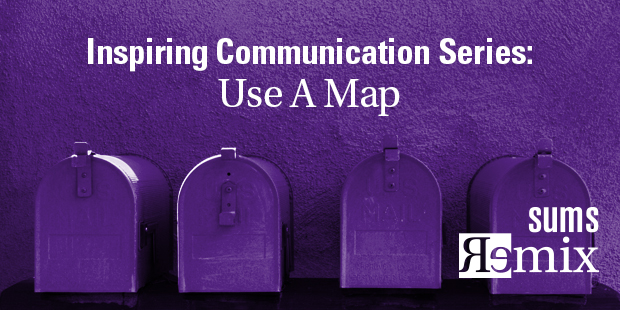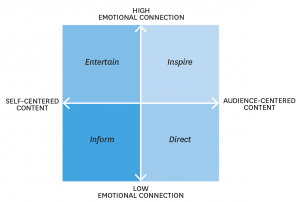
Inspiring Communication Series: Use a Map
To help others see change, the leader must understand how to unlock the imagination.
The very act of imagination is connected to faith. The author of Hebrews writes, “Now faith is the assurance of things hoped for and the conviction of things not seen” (Hebrews 11:1). When a leader articulates, or provokes, a follower’s imagination, he or she is serving both God and the individual by exercising the muscle of faith.
Unlock the imagination of your audience by using a map.
THE QUICK SUMMARY – Communicate to Influence by Ben Decker
Business communication is annoying. At each meeting and presentation, we are inundated with information, leaving us thirsting for inspiration. Sure, we will check off an action item because we have to . . . but what if we were actually inspired to do something? What if we were so moved that we wanted to do it?
Leaders must earn the license to lead. Not by expertise, authority, or title alone, but by influence. In Communicate to Influence, you will learn the secrets of the Decker Method―a framework that has been perfected over the past 36 years. Ben and Kelly Decker add fresh insights to these proven principles so that you can ignite change and inspire action. Discover:
- The Five White Lies of Communicating: learn which barriers prevent you from getting better
- The Communicator’s Roadmap: use a tool to visually chart what type of communication experience you create
- The Behaviors of Trust: align what you say with how you say it to better connect with your audience
- The Decker Grid: shift your message from self-centered, all about me content to relevant, audience-centered content that drives action
You are called to communicate well. Not only on the main stage, under bright lights, but every time you speak with your colleagues, your clients, and other stakeholders. It’s time to learn how. Stop informing. Start inspiring.
A SIMPLE SOLUTION
When you inspire people, it is much easier to persuade them to buy into your vision and goals. In fact, they will move from a position of “have to” to “want to.”
How do we create an ideal communication experience for our audience? We begin by understanding what experience we are creating as communicators and by becoming focused and intentional about that experience. We need a navigational tool to help us get where we want to be. We must treat every communication situation like a new location, and input the destination of where we want to go. We need the Communicator’s Roadmap.
The vertical axis graphs our emotional connection with our audience. The emotional connections are what determine whether or not people like us, trust us, and want to follow. If there is emotional distance our audience will be disinterested or disengaged. At the opposite end of the spectrum, if you were emotionally connected to the speakers, you like them, trusted them, related to them, wanted to be around them, or at lease wanted to keep listening to them.
The horizontal axis represents our content, the actual message that we deliver. Are you distributing information, or are you driving action? The left side of the axis is reserved for information sharing. If the content is totally focused on your agenda, your ideas, and your goals, you have self-centered content.
The more you are able to focus your content and make it audience-centered, serving the wants, needs, desires, goals, and priorities of the audience, the more you shift the experience to the right side of the horizontal axis. The right side of this axis is action-oriented, and it is the part of the Communicator’s Roadmap from which influence flows.
Audience-centered content transforms the whole experience. You’ll influence the people in your audience and motivate them to action – and action is what communication is all about.
Ben Decker and Kelly Decker, Communicate to Influence
A NEXT STEP
The quadrants depicted and described above represent the types of experiences you need to create, not the type of communicator you always are. The descriptions should serve as reference points as you prepare for your next presentation.
Each key communication situation in your role as a leader needs a definition, so map it. Be intentional about the kind of experience you want to create and be intentional about where you’re going.
To help you become more comfortable with the map depicted above, practice the following exercises:
- A communicator’s highest goal should be to inspire (upper right quadrant). Think about a recent presentation or sermon you delivered.
- What quadrant did it start in (if not Inspire)?
- What kinds of actions could you take to move it toward the Inspire quadrant?
- Over the next week, observe people in various communication settings. Notice where they fall on the map. As a listener, how are you impacted by where they are on the map?
- The next time you dine out, don’t just focus on the food but think about the whole experience. How did the whole experience add to (or take away) from your meal? When you are preparing your next presentation, use your dining experience feelings to help you focus your total presentation experience.
- The next time you are at an event with multiple speakers, create a map of each of them, noting which quadrant they started in and where they finished. What stood out about the journey? Which speakers inspired you the most? What lessons can you apply to your own speaking journey?
As leaders, we communicate in all we say and do. We may be entertaining at times, we inform much of the time, and occasionally we must be directing in what we say. But in all situations, we can inspire and connect with our audience.
It’s not what the leader thinks can be or even should be, but what must be.
Taken from SUMS Remix 29-3, published December 2015.
This is part of a weekly series posting content from one of the most innovative content sources in the church world: SUMS Remix Book Summaries for church leaders. SUMS Remix takes a practical problem in the church and looks at it with three solutions; and each solution is taken from a different book. As a church leader you get to scan relevant books based on practical tools and solutions to real ministry problems, not just by the cover of the book. Each post will have the edition number which shows the year and what number it is in the overall sequence. (SUMS provides 26 issues per year, delivered every other week to your inbox).

Tags: Ben Decker, Communicate to Influence, Communication, Kelly Decker, SUMS Remix













